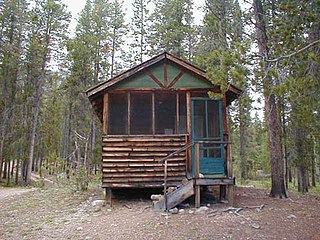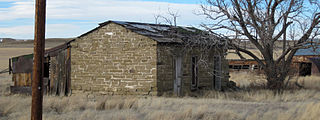
Pecos National Historical Park is a United States National Historical Park in San Miguel County, New Mexico. The park, operated by the National Park Service, encompasses thousands of acres of landscape infused with historical elements from prehistoric archaeological ruins to 19th-century ranches, to a battlefield of the American Civil War. Its largest single feature is Pecos Pueblo also known as Cicuye Pueblo, a Native American community abandoned in historic times. First a state monument in 1935, it was made Pecos National Monument in 1965, and greatly enlarged and renamed in 1990. Two sites within the park, the pueblo and the Glorieta Pass Battlefield, are National Historic Landmarks.

There are more than 1,500 properties and historic districts in the U.S. State of Colorado listed on the National Register of Historic Places. They are distributed over 63 of Colorado's 64 counties; only the City and County of Broomfield currently has none.

Yuma Crossing is a site in Arizona and California that is significant for its association with transportation and communication across the Colorado River. It connected New Spain and Las Californias in the Spanish Colonial period in and also during the Western expansion of the United States. Features of the Arizona side include the Yuma Quartermaster Depot and Yuma Territorial Prison. Features on the California Side include Fort Yuma, which protected the area from 1850 to 1885.

Warner's Ranch, near Warner Springs, California, was notable as a way station for large numbers of emigrants on the Southern Emigrant Trail from 1849 to 1861, as it was a stop on both the Gila River Trail and the Butterfield Overland Mail stagecoach line (1859-1861). It was also operated as a pioneering cattle ranch.

Oak Grove Butterfield Stage Station is located in the western foothills of the Laguna Mountains, in northern San Diego County, California. It is located on State Route 79, 13 miles (21 km) northwest of Warner Springs and Warner's Ranch. The station was built on the site of Camp Wright, an 1860s Civil War outpost.

Watrous, also named La Junta, is a National Historic Landmark District near Watrous, New Mexico. It encompasses the historic junction point of the two major branches of the Santa Fe Trail, a major 19th-century frontier settlement route between St. Louis, Missouri and Santa Fe, New Mexico. La Junta, marked this junction point, as well as the first major indications of civilization before westbound travelers reached Santa Fe. The district includes a large area west of the modern community of Watrous, encompassing the confluence of the Mora and Sapello Rivers. Surviving buildings include the houses of early ranchers, as well as a stagecoach mailstop and inn. The district was designated a National Historic Landmark in 1963.

Boggsville is a former settlement in Bent County, Colorado, USA near the Purgatoire River about 3 miles (4.8 km) above the Purgatoire's confluence with the Arkansas River. It was established in 1866. The surviving structures are among the earliest examples of Territorial architecture in Colorado. Boggsville was the last home of frontiersman Kit Carson before his death in 1868 at Fort Lyon. The U.S. Post Office at Las Animas now serves Boggsville postal addresses.
The Fort Laramie Three-Mile Hog Ranch was built to serve as a social center away from the soldiers' post at historic Fort Laramie. Fort Laramie was a 19th-century military post in eastern Wyoming. It became notorious as a place for gambling and drinking, and for prostitution, with at least ten prostitutes always in residence. The location is notable as an example of one of only a few military bordellos still standing in the United States by 1974, the time of its nomination to the National Register of Historic Places The Fort Laramie site was one of a number of so-called "hog ranches" that appeared along trails in Wyoming.

Pinery Station, or The Pinery, was built as a relay station on the Butterfield Overland Mail stagecoach route, located at the crest of Guadalupe Pass in what is now Guadalupe Mountains National Park in the U.S. state of Texas. The station, now in ruins, was built in 1858 and was abandoned the next year. It is located close by U.S. Routes 62/160 and is accessible for tourists.

The Seventeen Mile House is a historic site and open space located at 8181 S. Parker Rd. in Centennial, Colorado. It is a 33-acre former stagecoach stop with a square log structure covered with clapboard. It was a stopping place during the 1800s along the Smoky Hill Trail. It is one of the last two remaining trail houses left on the trail. Mary Hightower was the original owner of the house, having moved there in 1866. It was almost torn down in 1977 until negative publicity stopped it from happening. The site was zoned for commercial development until the County of Arapahoe acquired the land in 2001.

The Holzwarth Historic District comprises a series of cabins built by the Holzwarth family as a guest ranch inholding within the boundaries of Rocky Mountain National Park, at Grand Lake, Colorado. The Holzwarths made their homestead in the Kawuneeche Valley in 1917, two years after the establishment of the park, and received a patent on the homestead in 1923. Guest ranch use began in 1919 and continued until the ranch was purchased by The Nature Conservancy in 1974. The property was transferred to the National Park Service in 1975 for incorporation into the park. The district comprises a number of rustic cabins on the Colorado River. Operations existed on both sides of the river, first known as the Holzwarth Trout Ranch and later as the Never Summer Ranch. All but Joe Fleshut's cabin have been removed from the east side of the river.

The Powder River Crossing, officially known as Powder River Station-Powder River Crossing , is an abandoned settlement located on the east bank of the Powder River in southeast Johnson County about twenty-four miles east of Kaycee, Wyoming. It developed after a wooden toll bridge was built across the Powder River in 1877, at a site that was originally used as a ford. With crossing secured, a settlement developed here in the late 19th century, incorporating a stage stop on the Bozeman Trail. The site is notable for having well-preserved wagon ruts from the pioneer era.
Architects of the National Park Service are the architects and landscape architects who were employed by the National Park Service (NPS) starting in 1918 to design buildings, structures, roads, trails and other features in the United States National Parks. Many of their works are listed on the National Register of Historic Places, and a number have also been designated as National Historic Landmarks.
The Lost Lake Trail near Estes Park, Colorado, also known as, or including, Sawmill Trail, is a 9-mile-long (14 km) trail through what is now Roosevelt National Forest and then through what is now Rocky Mountain National Park (RMNP).

The Peavine Ranch, at 11220 N. Virginia St. in Reno, Nevada, is a historic 5.2-acre (2.1 ha) property with significance dating to 1862. It was listed on the National Register of Historic Places in 2000; the listing included five contributing buildings. It was once a stagecoach stop, but became a ghost town after a fire in 1900.

The Stone Ranch Stage Station is a stagecoach station located near U.S. Routes 20 and 26 northwest of Casper, Wyoming. The station opened in 1890 along a stagecoach line connecting Casper to Lander and Thermopolis. As railroads had not been built further than Casper, the stagecoach provided the primary means of bringing settlers and goods into central Wyoming. The stagecoach station provided food and shelter to travelers along the stagecoach line. After the Chicago and Northwestern Railroad extended its line further into central Wyoming in the early 20th century, the stagecoach line became obsolete and the station closed. It is one of the few Wyoming stagecoach stations which is still standing and relatively intact.
The Behrman Ranch, near Buena Vista, Colorado, was listed on the National Register of Historic Places in 2012.

Six Mile Creek Stage Station Historic District is the site of a stagecoach station and ranch on the Santa Fe Trail in western Morris County, Kansas. The site is located near the trail's crossing of Six Mile Creek, which was named for its location 6 miles (9.7 km) west of Diamond Spring. After the stagecoach station at Diamond Spring was destroyed, a new station was built at Six Mile Creek in 1863. The station lasted until later in the 1860s, when new railroad construction made the stage line obsolete. Charley Owens began a ranch at the site in 1866, and while his ranch only lasted two years, the site was sporadically used for ranching and farming into the twentieth century. In addition to the ruined stage station, the site includes the remnants of a barn, blacksmith shop, corral, and well, along with several ruts from the trail.














